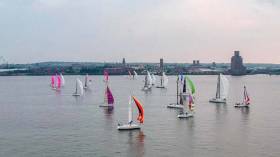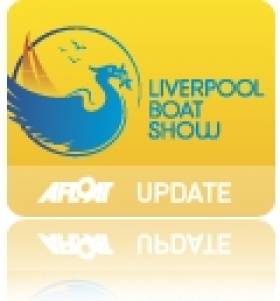Displaying items by tag: Liverpool Yacht Club
Irish Yachts Welcome To Compete In Or Cruise With 100th Isle Of Man Midnight Race Next Month
Liverpool Yacht Club (LYC) and Tranmere Sailing Club (TSC) have announced the 100th Isle of Man Midnight Race on Friday 5 July.
The century race to the Isle of Man will start from the international start line outside the Royal Albert Dock in Liverpool, and a spectacular Parade of Sail around Royal Albert and Canning Docks is planned to commence around 12.30pm.
Sir Robin Knox-Johnson, President of the Liverpool Yacht Club and Tranmere Sailing Club alliance, said: “The 100th Liverpool to the Isle of Man race is the cause of a major celebration, not just for the club but for yacht racing generally.
“Yachting was becoming more accessible 100 years ago and offshore races were an inevitable development, and the Liverpool [Bay] Yacht Club [in 1907] was right up there setting an example before the Fastnet Race was introduced.
“This coming fifth of July will be an important date for the club and for Irish Sea yachting when the 100th race starts. We hope for a large fleet and a fast and exciting race to celebrate the initiative of the founders and to provide a good start to the second century.”
Yachts and their crew from all over the Irish Sea and surrounding areas are invited to join the prestigious event, which was won last year by leading ISORA boat Mojito.
There will be two courses incorporating the original 75-mile Isle of Man course, with an extended section for those wishing to complete the RORC race which has a minimum distance of 100 miles and will be a qualifying distance for races such as the Fastnet taking place later this year.
All competitors will race for the opportunity to win the Grand Challenge Trophy, one of only four such trophies in existence (another is given to the winner of the Australian Open Tennis Championship).
And those completing the 100 mile course will compete for the Lyver Trophy, a beautiful Waterford Glass award. Other awards will be made to class winners.
Sir Robin noted that “our sport is becoming noticeably much more inclusive” and in this spirit LYC/TSC are also encouraging vessels either sail or powered to cruise in company with the race and join in the socials at Liverpool Marina on Wednesday 3 July, a pre-race social at Revolución de Cuba, Liverpool on Thursday 4 July (contact [email protected]) and the race final celebration at Douglas Bay Yacht Club on Saturday 6 July.
LYC Commodore Neil Thomas said: “Join us for some of the very best racing in the Irish Sea, plus some amazing craic afterwards!”
The Isle of Man midnight race is hosted by the LYC/TSC in association with the Royal Ocean Racing Club (RORC), Irish Sea Offshore Racing Association (ISORA), Royal Dee Yacht Club (RDYC) and Douglas Bay Yacht Club (DBYC).
If you are interested in participating in the race itself, contact [email protected] for race entry information.
Mersey's Biggest Sailing Event to be Staged at Liverpool Boat Show
About 150 boats will compete in a series of spectacular races on each of the two weekends of the show, which takes place from April 29 to May 8 next year.
Up to three races will be held each day on the weekends of April 30 and May 7, with classes for modern racing yachts, ultra-fast multi-hulls, local classes and traditional nobbys.
The regattas – comprising the Royal Dee Yacht Club Spring Regatta and the Liverpool Yacht Club Kindred Clubs Regatta – will be one of the main highlights of the Liverpool Boat Show, which takes place in the splendid surroundings of the Albert Dock.
Competitors from across the UK and Ireland are expected to take part in the regattas, which will see boats racing against each other on courses in front of the Albert Dock.
Today organisers urged enthusiasts and clubs to submit their entries for the races to secure a place in one of the most spectacular sailing events of the year.
Alastair Soane, chair of the race committee, said: "This will be the biggest sailing event for probably 70 or 80 years on the River Mersey and interest is already very high."
Alastair Soane, a past Commodore and President of Liverpool Yacht Club who sits on the steering committee of the boat show, added: "We already have expressions of interest from clubs and individuals in Scotland, Wales and Ireland and we are keen to get representation from the sailing fraternity right across the UK, including the South coast.
"The combination of the festival atmosphere of the show and the spectacle of the racing will make these truly unique events and we'd urge potential participants to register as soon as possible."
A number of North West clubs are supporting the regattas, including Liverpool Yacht Club, the Royal Mersey Yacht Club, the Royal Dee Yacht Club, West Kirby Sailing Club, Wallasey Yacht Club, Dee Sailing Club, Blundell Sands Sailing Club, Liverpool Sailing Club, Hoylake Sailing Club, West Lancs Sailing Club and the Nobby Association.
Mr Soane said: "The entire North West sailing community is throwing its weight behind the Liverpool Boat Show and we are determined to make it a show like no other and to showcase to a whole new generation the pleasure and benefits to be had from sailing."






























































